MT17MAG47K-PX25
MILLIPLEX® Mouse TH17 Magnetic Bead Panel - Premixed 25 plex - Immunology Multiplex Assay
Simultaneously analyze multiple Th17 cytokine and chemokine biomarkers with the Th17 Bead-Based Multiplex Assays using the Luminex technology, in human serum, plasma and cell culture samples.
Sinónimos:
Mouse TH17 Panel, TH17 Magnetic Bead Panel
About This Item
Productos recomendados
Quality Level
species reactivity
mouse
manufacturer/tradename
Milliplex®
assay range
accuracy: 85-110%
linearity: 111.0%
(1:04)
linearity: 113.1%
(1:08)
standard curve range: 1.5-1,500 pg/mL
(IL-4)
standard curve range: 10-10,000 pg/mL
(IL-17F)
standard curve range: 127-130,000 pg/mL
(IL-28B)
standard curve range: 15-15,000 pg/mL
(IL-1β)
standard curve range: 2.4-2,500 pg/mL
(IL-22)
standard curve range: 20-20,000 pg/mL
(IL-10, IL-12(p70), & IL-21)
standard curve range: 3.4-3,500 pg/mL
(TNFα)
standard curve range: 34-35,000 pg/mL
(GM-CSF & IL-15)
standard curve range: 342-350,000 pg/mL
(IL-23)
standard curve range: 39-40,000 pg/mL
(IL-13 & IL-17A)
standard curve range: 4.9-5,000 pg/mL
(IL-5)
standard curve range: 488-500,000 pg/mL
(TNFβ)
standard curve range: 49-50,000 pg/mL
(CD40L IL-31 & MIP-3α)
standard curve range: 586-600,000 pg/mL
(IL-17E/ IL-25)
standard curve range: 6.9-6,000 pg/mL
(IL-2)
standard curve range: 7.8-8,000 pg/mL
(IFNγ & IL-6)
standard curve range: 78-80,000 pg/mL
(IL-33)
standard curve range: 879-900,000 pg/mL
(IL-27)
technique(s)
multiplexing: suitable
compatibility
configured for Premixed
detection method
fluorometric (Luminex xMAP)
shipped in
wet ice
General description
Th17 cells are involved in the clearance of extracellular bacteria and fungi. They are abundant in the intestinal lamina propria and function as a barrier against invading pathogens. Excessive amounts of Th17 cells have been implicated in the pathogenesis of several autoimmune diseases, including multiple sclerosis, psoriasis, juvenile diabetes, rheumatoid arthritis, Crohn′s disease, and autoimmune uveitis. In addition, Th17 cells play an important role in tumor development, progression, and metastasis, potentially in both promoting and inhibiting tumor growth.
The MILLIPLEX® Mouse Th17 Bead panel enables you to focus on the therapeutic potential of the modulation of CD4 T-helper cell cytokines. Coupled with the Luminex® xMAP®platform in a bead format, you receive the advantage of ideal speed and sensitivity, allowing quantitative multiplex detection of dozens of analytes simultaneously, which can dramatically improve productivity.
Panel Type: Cytokines/Chemokines
Specificity
There was no or minimum cross-reactivity between the antibodies and any other analytes in the panel (see details in assay protocol).
application
- Analytes: CD40 Ligand, GM-CSF, IFN-γ, IL-1β, IL-2, IL-4, IL-5, IL-6, IL-10, IL-12 (p70), IL-13, IL-15, IL-17A, IL-17E/IL-25, IL-17F, IL-21, IL-22, IL-23, IL-27, IL-28B, IL-31, IL-33, MIP-3α/CCL20, TNF-α, TNFβ
- Recommended Sample type: serum, plasma or tissue/cell lysate and culture supernatant
- Recommended Sample dilution: neat
- Assay Run Time: overnight or one day
- Research Category: Inflammation & Immunology
Storage and Stability
Other Notes
Legal Information
Disclaimer
signalword
Danger
Hazard Classifications
Acute Tox. 4 Dermal - Acute Tox. 4 Inhalation - Acute Tox. 4 Oral - Aquatic Chronic 2 - Eye Dam. 1 - Skin Sens. 1 - STOT RE 2
target_organs
Respiratory Tract
Storage Class
10 - Combustible liquids
Certificados de análisis (COA)
Busque Certificados de análisis (COA) introduciendo el número de lote del producto. Los números de lote se encuentran en la etiqueta del producto después de las palabras «Lot» o «Batch»
¿Ya tiene este producto?
Encuentre la documentación para los productos que ha comprado recientemente en la Biblioteca de documentos.
Nuestro equipo de científicos tiene experiencia en todas las áreas de investigación: Ciencias de la vida, Ciencia de los materiales, Síntesis química, Cromatografía, Analítica y muchas otras.
Póngase en contacto con el Servicio técnico










